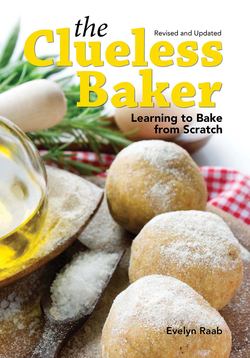Читать книгу The Clueless Baker - Evelyn Raab - Страница 12
ОглавлениеFlour
Is nothing ever simple? You’ll definitely need flour. But what kind of flour? Or didn’t you know you had a choice?
For general baking purposes, we mean wheat flour. It’s made from (surprise!) wheat and is available in many different types. Each type is best suited for a specific purpose.
Here is a list of the most commonly used types of wheat flour:
All-purpose white flour is the most widely available kind of flour. It comes in small bags or in bulk and is sold under many different brand names. If the bag says nothing else (such as unbleached or whole wheat), you can assume you’ve got all-purpose white flour. This product has been milled; the bran has been sifted out; and the flour has been bleached by chemical means to make it dazzlingly white. Vitamins and whatnot are added to replace some of the nutrients that were lost in the refining process. As the name suggests, all-purpose white flour is suitable for most baking purposes unless the recipe specifies another type of flour.
All-purpose unbleached white flour is white flour that hasn’t been subjected to a bleaching process and therefore remains creamy white in color. All-purpose unbleached white flour can be used in any recipe that calls for all-purpose flour. Some people prefer to use it because it has undergone less processing than bleached flour.
Cake and pastry flour is made from soft wheat — a variety of wheat that has a lower gluten (see below) and protein content. It’s often recommended for baking cakes and pastry, where you’re more interested in lightness and fluffiness than in sturdiness. With only one exception, regular all-purpose flour is perfectly adequate for every recipe in this book. The one exception is Angel Food Cake, which is just delicate enough to require cake and pastry flour.
Whole wheat flour is milled kernels of hulled whole wheat. Period. Nothing has been taken out. The outside layer of bran and the wheat germ are both left in the flour. Whole wheat flour is darker in color than white flour, and has a hearty wheat flavor and a coarser texture. It contains all the nutrients found in wheat and provides a hefty dose of fiber. Use whole wheat flour by itself or mixed with white flour when baking breads or cookies — you may want to experiment with different combinations until you find a mixture that you like. Whole wheat flour should be stored in the refrigerator or freezer to prevent it from developing an off taste — the oil in the wheat germ can turn funny after a while at warm room temperature.
Gluten-free all-purpose flour is a wheat-free product that can be substituted for regular wheat-based all-purpose flour in many recipes. Gluten-free flour is usually some blend of garbanzo flour, potato starch, tapioca starch, sorghum flour, rice flour and/or cornstarch, among other things. Different commercial brands of gluten-free flour are made of different combinations of ingredients. As a very general rule, if a recipe contains ½ cup (125 ml) or less of regular flour, you can substitute the same quantity of gluten-free flour. The results will probably be slightly different from the original version of the recipe, but if you must avoid gluten, it’s definitely worth experimenting.
